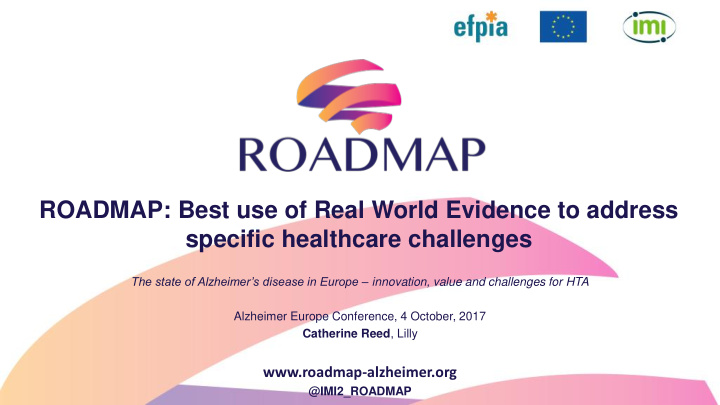



ROADMAP: Best use of Real World Evidence to address specific healthcare challenges The state of Alzheimer’s disease in Europe – innovation, value and challenges for HTA Alzheimer Europe Conference, 4 October, 2017 Catherine Reed , Lilly www.roadmap-alzheimer.org I 1 10-Oct-17 www.roadmap-alzheimer.org @IMI2_ROADMAP
Objectives for this presentation What is real world evidence (RWE) and what is it used for? What are the challenges for RWE in AD and will the goals of ROADMAP address these? What input from individuals and caregivers can benefit the ROADMAP deliverables? I 2 10-Oct-17 www.roadmap-alzheimer.org
Real World Evidence (RWE) E.g. medical records, insurance data, cohort studies One form of evidence (along with RCT*, health economics studies, etc.) taken from primary or secondary/existing real world data sources for the purpose of providing insights, on diseases, medicines, patient populations and healthcare practices, that will inform decision making RWE potentially better informs regulators (on effectiveness and safety), payers and healthcare providers (cost effectiveness), industry (pricing and manufacturing), and scientists (mechanisms and diagnostic/treatment pathways) to assist decision-making on new and existing treatments. I 3 10-Oct-17 www.roadmap-alzheimer.org *RCT: Randomized Clinical Trials
Challenges for AD RWE Available data sources to inform the real world trajectory and impact of AD are limited Lack of consensus on study design and endpoints in real world data sources Lack of AD-related outcomes in medical records relevant across the spectrum of disease Lack of clarity on how best to model of natural history of the disease using real world data sources Severe AD Prodromal/MCI Mild AD Pre-clinical Moderate AD AD Dementia Dementia due to AD Dementia Positive Amyloid PET Imaging Scan and/or A β CSF/ Tau changes Asymptomatic/ Multi-domain Severe cognitive Memory impairment potential slight memory deficit impairment impairment No functional Some impairment of Functional impairment complex function (iADLs) impairment Behavioural symptoms Nursing home/ Some assistance full time care I 4 10-Oct-17 www.roadmap-alzheimer.org
Opportunities Leverage existing large data set to perform pilots Harmonize collation methods and analytical tools I 5 10-Oct-17 www.roadmap-alzheimer.org
What is ROADMAP? Real world Outcomes across the AD spectrum for better care: Multi- modal data Access Platform (ROADMAP) ROADMAP is a private-public partnership (PPP) to explore the usability of all available data sources in the decision-making process Goal is to bring data together for the benefit of individuals with AD and their caregivers This project has received funding from the Innovative Medicines Initiative 2 Joint Undertaking under grant agreement No 116020 (“ROADMAP”). This Joint Undertaking receives support from the European Union’s Horizon 2020 research and innovation programme and EFPIA. I 6 10-Oct-17 www.roadmap-alzheimer.org
ROADMAP Consortium Public partners EFPIA partners Associated Data Providers EMA- National/Regional NICE/HTA/payers Health Authorities Qualification Pilot to comprise an Expert use of RWE in AD Advisory Group (EXAG led by NICE): Related projects (1) HTA bodies/payers from different archetypes (2) Regulators (3) Patient Associations I 7 10-Oct-17 www.roadmap-alzheimer.org
ROADMAP Structure WP1 – Project Management Executive Committee (UOXF, EMC, NOVARTIS, Eli Lilly, BIOGEN, NICE, SYNAPSE) √ WP2 – Outcome Definition WP8 – Ethical, Legal and WP6 – Regulatory and Social Implications (ELSI) HTA Engagement WP3 – Identification, Mapping and Integration of RWE WP4 – Disease Modelling and Simulation √ √ WP5 – Health Economics √ WP7 – Communication and Patient/Healthcare/ Provider Engagement I 8 √ 10-Oct-17 www.roadmap-alzheimer.org Patient association involvement
Objectives Develop and implement a communication strategy focussing on the needs of patients and professionals – Involve national patient groups/Alzheimer associations to further disseminate and communicate project results and achievements at a national level – Special attention will be paid to outreach activities that align with patient and carer needs and interests and synergies with other IMI projects. – Engagement with policy makers at EU and national level and interact with the European Alzheimer’s Alliance to promote a RWE approach and the findings of the project. – Establish a group of interest for the second phase of the project, especially involving scientists, companies, individuals with AD and carers, Alzheimer associations and general public. I 9 10-Oct-17 www.roadmap-alzheimer.org
Objectives Define and catalogue scales and consensus-based methodologies for identifying AD outcomes from routinely collected data e.g. in cognition, dependency, caregiver impact – Input on the most important measures from partners in Alzheimer Europe via patients, carers and associated charities who are willing and able to: • provide input to survey content • contribute to survey feedback • participate in outcome prioritisation workshops I 10 10-Oct-17 www.roadmap-alzheimer.org
Objectives Develop guiding principles and recommendations from HTA/payers/regulators for the development and incorporation of RWE into clinical and market access development plans for AD – Attending meeting alongside regulator and payers stakeholders to evaluate and inform on ROADMAP plans and output I 11 10-Oct-17 www.roadmap-alzheimer.org
Objectives Develop an ELSI* framework with extensive patient involvement for the development and application of RWE in AD – Participation of AE in the ethics advisory board – Input into areas of re-purposing data, prioritizing outcomes and defining clinically relevant progression – Participation in focus groups to collect patient attitudes towards the specific platform and data integration proposed by ROADMAP I 12 10-Oct-17 www.roadmap-alzheimer.org *ELSI: Ethical, Legal and Social Implications
Impact of ROADMAP More transparent, open and widely accepted outcomes in AD will aid more streamlined decision making for access to new therapies. Data integration requirements for improved understanding of AD progression and treatment benefits. Establish consensus across industry and public consortium with stakeholder engagement. I 13 10-Oct-17 www.roadmap-alzheimer.org
THANK YOU I 14 10-Oct-17 www.roadmap-alzheimer.org
Recommend
More recommend